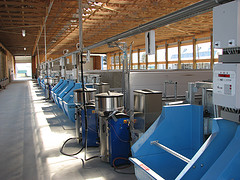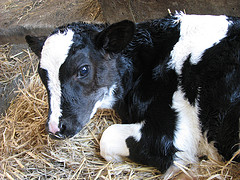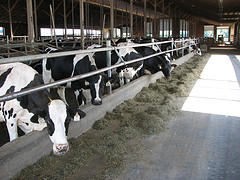Previous research on milk-fed calves has shown that calves are highly motivated to consume at least twice as much milk as they have traditionally been provided (i.e. approximately 8 versus 4 L/d). When allowed to consume more milk calves gain weight more quickly and are less hungry. Faster growing calves turn into faster growing heifers – they are able to calve out at younger ages and ultimately produce more milk, particularly during the first lactation. For these reasons the new Code of Practice for the Care and Handling of Dairy Cattle states that calves should be offered a minimum total daily intake of 20% of body weight in whole milk (or equivalent nutrient delivery via milk-replacer), ideally via a nipple-based system.
These new calf-feeding methods work well for individually housed calves, and also facilitate group housing because well-fed calves are less motivated to perform abnormal sucking behaviour, such as crosssucking. Group housing of dairy calves provides a number of advantages to calves and producers. In particular, group living allows calves (like other social animals) to learn from social interactions with pen mates. New UBC results show, group rearing also allows calves to better adapt to changing environments, meaning that they transition more smoothly to new diets, new feeding systems, and regrouping.
One key advantage of group housing is that calves take advantage of ‘social learning’ to more quickly discover and make use of solid feed. This means that young group housed calves start ingesting solid food earlier than individually housed calves; these calves benefit because early intakes of solids helps to minimize weaning distress and improve calf performance after weaning.
The simplest approach to group housing is to keep calves in pairs. When compared to single housing, pair housing doubles solid feed intake during the pre-weaning period. Moreover, when pair housed calves are weaned off milk, they vocalize much less than do individually housed calves in part because they are better established on solids and thus less dependent upon milk. Work on other species has also shown that having a social companion reduces an animal’s response to stressful events like weaning.
Pair housing also has longer-term advantages for the calf. For example, when calves are introduced to a novel group pen after weaning and need to operate automatic feeders for the first time, those that had previously been single housed require almost 2 days before they are eating starter, in comparison to just 9 hours for the pair-housed calves. This delay to consume starter by individually-housed calves reduces calf weight gains soon after mixing (Figure 1) and reflects an inability to properly adjust to novelty, likely due to both social and cognitive deficits.

Figure 1. The effect of mixing pair and individually
housed dairy calves on growth rate (kg/d/calf).
Calves reared individually lost weight during the
first 3 d after mixing.
The social deficit becomes especially clear when individually housed calves meet unfamiliar calves for the first time. Individually housed calves explore and run less, tend to spend more time standing idle, defecate more, kick more, and engage in fewer head-to-head interactions (an indicator of social cognition) and synchronous running events (an indicator of social cohesion) than do pair housed calves. Individually housed calves also require more time before they initiate physical contact with calves they are not familiar with, but when they do they become highly persistent in maintaining contact compared to pair
housed calves. This difference seems to reflect an inability of individually reared calves to regulate their social behaviour.
Individually housed calves are also more sensitive to a novel environment than pairhoused calves. When introduced to a novel area, they defecate more and are more cautious when exploring.
In combination, these results indicate that pair housing during the milk-feeding stage reduces calf negative responses to weaning and improves performance after weaning (when calves are typically housed in groups). Moreover, it appears that individual housing during the milk-feeding period results in cognitive and social deficits in calves. It is not know if calves recover from these deficits with later exposure to social housing.
It is possible that deficits in calf cognition have long lasting effects on how these animals thrive in commercial systems. For example, on modern dairy farms cattle must learn to interact with new technologies such as robotic milkers and computerised feeders, as well as to learn to navigate the social complexities associated with frequent group changes and changes in housing, diet, etc. Thus providing calves with early social experience may be especially beneficial for the management of cattle on larger farms that are more likely to encounter these practices and technologies. The simplest group is a pair, and we encourage producers who are interested in transitioning to group housing to start by keeping calves in pairs. Pairing can occur soon after birth, but calves likely benefit most from social contact after the first week of life.
Are you interested in seeing how individually housed calves respond to unfamiliar companions? Check out this short video:
We are grateful to Dr. Andreia De Paula Vieira for her help preparing this report. For further information please email marina.vonkeyserlingk@ubc.ca or dan.weary@ubc.ca. This report is based on two papers published in the Journal of Dairy Science (De Paula Vieira et al. 2012. J. Dairy Sci. 95:5149–5155; De Paula Vieira et al. 2010. J. Dairy Sci93: 3079-3085). We thank the researchers and staff of the UBC Dairy Education and Research Centre who collaborated in the work described in this report. This research was funded by NSERC. The UBC Animal Welfare is also supported by the Dairy Farmers of Canada and many others listed at http://awp.landfood.ubc.ca/





